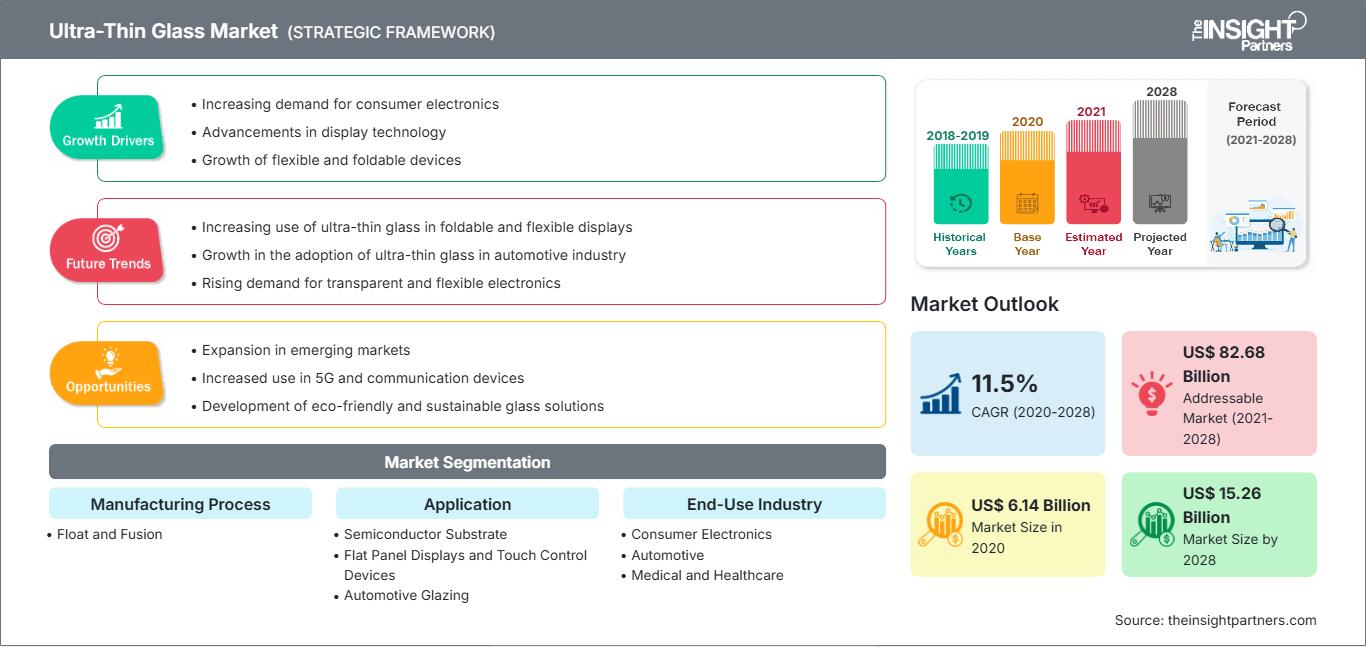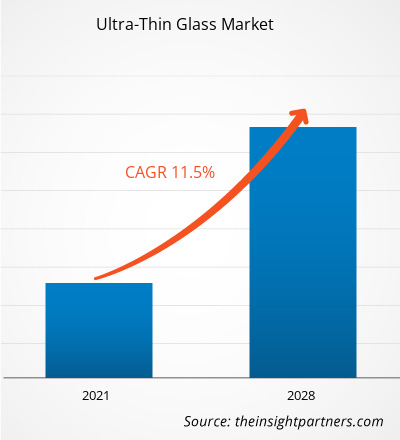[研究报告]2020年超薄玻璃市场规模为61.3956亿美元,预计到2028年将达到152.6474亿美元;预计2021年至2028年的复合年增长率为11.5%。
超薄玻璃是指厚度小于1.2毫米的玻璃。
通过离子交换进行化学强化通常用于增强用于高科技应用的超薄玻璃。
硬化超薄玻璃具有耐刮擦性,可弯曲半径达几毫米。超薄玻璃具有耐腐蚀、透明、柔韧性、优异的气体和水阻隔性以及高抗冲击性等特性,适用于平板显示器、汽车玻璃等各种应用。 2020 年,亚太地区占据全球超薄玻璃市场的最大收入份额。中国是超薄玻璃的最大消费国,占亚太地区 50% 以上的市场份额。中国是所有类型消费电子产品(例如智能手机和液晶显示器)的主要制造中心。
持续的新冠疫情彻底改变了化学品和材料行业的现状,并对超薄玻璃市场的增长产生了负面影响。
为防止新冠病毒传播而采取的措施加剧了形势,并对多个行业的增长产生了负面影响。由于国内和国际边界的突然关闭,汽车和消费电子等行业受到运营效率突然扭曲和价值链中断的负面影响。多个行业增长的下降对全球市场对超薄玻璃的需求产生了负面影响。然而,随着各经济体计划复苏,预计未来几年全球对超薄玻璃的需求将上升。受疫情影响,远程办公文化和在线教育的普及度不断提升。因此,笔记本电脑、智能手机和其他电信设备等产品的需求也在增长。汽车和消费电子等各行各业对超薄玻璃的需求不断增长,加上知名制造商的大力投资,预计将在预测期内推动超薄玻璃市场的增长。
自定义此报告以满足您的要求
您将免费获得任何报告的定制,包括本报告的部分内容,或国家级分析、Excel 数据包,以及为初创企业和大学提供超值优惠和折扣
超薄玻璃市场: 战略洞察

- 获取本报告的主要市场趋势。这个免费样本将包括数据分析,从市场趋势到估计和预测。
市场洞察 不断增长的消费电子行业
您将免费获得任何报告的定制,包括本报告的部分内容,或国家级分析、Excel 数据包,以及为初创企业和大学提供超值优惠和折扣
超薄玻璃市场: 战略洞察

- 获取本报告的主要市场趋势。这个免费样本将包括数据分析,从市场趋势到估计和预测。
随着智能手机、笔记本电脑、电视和其他电子产品等电子设备的使用日益增加,消费电子行业正在蓬勃发展。消费电子产品已成为科技世界中的必需品。各个世代的人都或多或少地依赖他们的智能手机、智能手表和笔记本电脑。随着消费电子行业的不断发展,制造商不断专注于提供先进和高质量的产品。超薄玻璃在消费电子行业中发挥着重要作用。它用于触摸和显示面板、传感器和摄像系统。超薄玻璃的各种特性,如耐腐蚀性、透明度、柔韧性和气体阻隔能力,使其适用于消费电子行业的众多应用。中国在消费电子产品行业占据主导地位。该国是平板显示器的主要制造国之一。对中国智能手机、健身追踪器、电视和其他电子产品的需求迅速增长,这为超薄玻璃制造商提供了有利可图的机会。中国加强了新基础设施建设;推动人工智能、工业互联网、物联网建设,加快5G商用步伐,推动电子信息制造业进入新的发展阶段,并进一步促进相关产业高端化发展。据《世界人口评论》统计,中国拥有16亿手机用户,印度拥有12.8亿手机用户。2018年,苹果智能手表出货量约为2250万块,较2017年有所增长,2017年售出1770万块。2018年,Fitbit智能手表出货量约为550万块,三星约为530万块。因此,快速增长的消费电子行业推动了对超薄玻璃的需求。
终端使用行业洞察
2020 年,消费电子领域占据了全球超薄玻璃市场的最大份额。超薄玻璃广泛用于制造电子产品,例如用于各种设备的平板显示器和触摸屏显示器,例如 LCD、OLED、智能手机和可穿戴设备。随着全球对创新和技术先进的电子产品的需求不断增长,预计未来几年对超薄玻璃的需求将会增加。
制造工艺洞察
按制造工艺划分,熔合工艺在 2020 年的超薄玻璃市场收入中占据主导地位。熔合工艺通常称为溢流下拉法,广泛用于制造用于显示面板的平板超薄玻璃。康宁是第一家创造出悬浮在半空中的特种玻璃的公司,这是熔合工艺的一个关键特征。玻璃不与熔融金属接触,这是熔融法相对于浮法玻璃法的一个根本优势。
超薄玻璃市场的一些主要市场参与者包括康宁公司、AGC 公司、日本电气硝子株式会社、肖特股份公司、中央硝子株式会社、南玻集团股份有限公司、Emerge Glass、日本板硝子株式会社、信义硝子控股有限公司和洛阳玻璃有限公司。市场的主要参与者正在采用并购和产品发布等策略来扩大其地理分布和消费者基础。
超薄玻璃市场
The Insight Partners 的分析师已详尽阐述了预测期内影响超薄玻璃市场的区域趋势和因素。本节还讨论了北美、欧洲、亚太地区、中东和非洲以及南美和中美洲的超薄玻璃市场细分和地域分布。
超薄玻璃市场报告范围
| 报告属性 | 细节 |
|---|---|
| 市场规模 2020 | US$ 6.14 Billion |
| 市场规模 2028 | US$ 15.26 Billion |
| 全球复合年增长率 (2020 - 2028) | 11.5% |
| 历史数据 | 2018-2019 |
| 预测期 | 2021-2028 |
| 涵盖的领域 |
By 制造工艺
|
| 覆盖地区和国家 | 北美
|
| 市场领导者和主要公司简介 |
|
超薄玻璃市场参与者密度:了解其对业务动态的影响
超薄玻璃市场正在快速增长,这得益于终端用户需求的不断增长,而这些需求的驱动因素包括消费者偏好的不断变化、技术进步以及对产品优势的认知度不断提高。随着需求的增长,企业正在扩展产品线,不断创新以满足消费者需求,并抓住新兴趋势,从而进一步推动市场增长。

- 获取 超薄玻璃市场 主要参与者概述
- 超薄玻璃行业的发展趋势,帮助参与者制定有效的长期战略
- 公司为确保在发达和发展中市场的增长而采取的业务增长战略
- 2019 年至 2028 年全球超薄玻璃市场的定量分析
- 对各行业超薄玻璃需求的估计
- 波特分析,说明行业买家和供应商预测市场增长的有效性
- 了解竞争激烈的市场形势和对超薄玻璃的需求的最新发展
- 市场趋势和前景,以及推动和抑制超薄玻璃市场增长的因素
- 了解支撑全球超薄玻璃市场增长商业利益的战略,有助于决策过程
- 不同市场节点的超薄玻璃市场规模
- 全球超薄玻璃市场及其行业动态
- 各地区超薄玻璃市场规模及增长机遇
超薄玻璃市场,按制造工艺
- 浮法
- 熔融
超薄玻璃市场,按应用
- 半导体基板
- 平板显示器和触控设备
- 汽车玻璃
- 其他
超薄玻璃市场,按最终用途行业
- 消费电子
- 汽车
- 医疗保健
- 其他
公司简介
- 康宁公司
- AGC公司
- 日本电气硝子株式会社有限公司
- 肖特股份公司
- 中央玻璃有限公司
- 南玻控股有限公司
- Emerge Glass
- 日本板硝子株式会社
- 信义玻璃控股有限公司
- 洛阳玻璃有限公司
- 历史分析(2 年)、基准年、预测(7 年)及复合年增长率
- PEST和SWOT分析
- 市场规模、价值/数量 - 全球、区域、国家
- 行业和竞争格局
- Excel 数据集
近期报告
相关报告
客户评价
购买理由
- 明智的决策
- 了解市场动态
- 竞争分析
- 客户洞察
- 市场预测
- 风险规避
- 战略规划
- 投资论证
- 识别新兴市场
- 优化营销策略
- 提升运营效率
- 顺应监管趋势






















 获取免费样品 - 超薄玻璃市场
获取免费样品 - 超薄玻璃市场